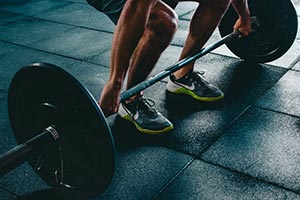Hip injuries are among the most common reasons baseball players are sidelined for a significant period. These account for about 5.5% of all baseball-related injuries. These figures represent a substantial number of players sidelined due to injury, which can profoundly impact their performance and longevity in the sport.
How Do Baseball Players Injure Their Hips?
Baseball is a sport that demands a lot from its players’ hips due to its unique mechanics. Unlike straight-line sports like sprinting and swimming, two key activities in baseball, namely batting and pitching, place significant rotational demands on the hips to perform flexion and powerful rotational movements.
- Pitching, for example, involves several phases, including wind-up, cocking, acceleration, and follow-through. Each of these stages applies different forces on the hips. During the wind-up, there’s a mix of bending and twisting. As the pitcher moves into the cocking and acceleration phases, the hips bear more load and twist even more. This continues right through the follow-through phase.
- Similarly, batting poses a challenge to the hips, especially the back hip, during the stance or coiling phase, where it’s subjected to twisting forces. This continues as the batter swings through to hit the ball, applying more rotational stress on the hips.
Other Factors That Contribute to the Likelihood of Hip Injuries
The stress placed on the hips during batting and pitching is inherent in the movements performed. However, other factors further increase the risk of injury among baseball players. These can include the following:
- Technique: Incorrect technique while batting, throwing, or pitching can increase pressure and twist in the hip, leading to potential injuries.
- Mobility and Movement Issues: Limited joint movement in the lower body or spine can lead to more hip problems.
- Strength and Endurance Deficits: Weak hip or core muscles can make the hips unstable, increasing the risk of injury. Similarly, fatigue can also contribute to injuries. Just as arm fatigue is monitored to prevent upper-body injuries, it’s essential to watch for signs of lower-body fatigue, which can affect performance and safety.
- Balance and Proprioception: Besides strength and flexibility, balancing and controlling body movements is crucial for preventing injuries. Poor balance or body awareness can strain or overextend joints and tissues.
- Joint Abnormalities: Any unusual structures within the joint might make players more prone to “impingement” or pinching during movement. Repeated stress in these conditions can lead to pain and inflammation.
Hip Exercises to Strengthen the Hips
You can avoid injuries by strengthening the muscles around the hips. Including targeted exercises in your regular training routine can help correct muscle imbalances and improve joint mobility. The following are some examples of exercises you can add to your routine to provide greater stability and reduce the risk of injuries:
Hip Flexor Stretches
Hip flexor stretches target the hip flexor muscles, which are pivotal in facilitating movement and flexibility in the hip area. Extending the range of motion and alleviating tightness, these stretches help maintain the hip flexors’ elasticity.
Here’s how to perform hip flexor stretches:
- Kneel on one knee, with the other foot flat on the ground in front of you, creating a 90-degree angle with both knees.
- Gently push your hips forward until you feel a stretch in the front of your hip on the kneeling side.
- Hold the stretch for 20-30 seconds, then switch legs.
- Perform this stretch 2-3 times per leg to improve hip flexor flexibility and reduce tightness.
Glute Bridges
Glute bridges reinforce the gluteal muscles. These muscles are instrumental in maintaining stability in the hips and pelvis, improving their ability to absorb and redistribute the rotational forces experienced during gameplay.
To perform glute bridges:
- Lie on your back with your knees bent and feet flat on the floor, hip-width apart.
- Push through your heels to lift your hips towards the ceiling, squeezing your glutes.
- Lower your hips back down to the starting position.
- Aim for 3 sets of 10-15 repetitions, focusing on activating your glutes to strengthen them and provide better hip stability.
Core Stability Exercises
While not directly part of the hip joint, a strong core is fundamental for efficient power transfer across the body’s kinetic chain while avoiding unnecessary strain on the hips.
Exercises like planks and resistance-based rotational movements are highly recommended as they can help improve core strength and stability.
To perform planks:
- Lie face down, then lift your body onto your toes and forearms, keeping your body straight from head to heels.
- Engage your core and hold this position for 30 seconds to 1 minute.
- Perform 2-3 sets, increasing the duration as your core strength improves.
For rotational movements with resistance:
- Stand with your feet shoulder-width apart, holding a resistance band or cable with both hands in front of you.
- Rotate your torso to one side, keeping your arms straight, then return to the center and rotate to the other side.
- Perform 2-3 sets of 10-12 repetitions on each side, focusing on engaging your core throughout the movement.
Band Walks
Lateral band walks are a great exercise focusing on the hip abductor muscles. They are especially beneficial for maintaining proper hip and knee alignment during gameplay.
To perform lateral band walks:
- Place a resistance band around your legs, just above your knees.
- Stand with your feet shoulder-width apart, knees slightly bent.
- Step to the side with one foot, then follow with the other, keeping tension in the band.
- Walk 10 steps in one direction, then 10 steps back to the starting point.
- Aim for 2-3 sets, focusing on keeping your hips stable and aligned.
Why You Should Seek Professional Help
Persistent hip pain can hamper your performance as an athlete or sportsperson. Whether you’re dealing with an injury or a chronic condition that limits mobility in your hips, it’s vital to seek professional help immediately to ensure a proper diagnosis and treatment plan.
As a professional baseball player, ignoring hip pain can worsen symptoms and potentially long-term damage. Seeking professional help as soon as possible helps alleviate pain and addresses the root cause of your discomfort. This can help prevent future injuries, helping you maintain peak performance and a prolonged career.
Personalized Treatment Plans at the American Hip Institute
At the American Hip Institute, we specialize in providing comprehensive care for athletes dealing with hip injuries and more. Our orthopedic specialists are dedicated to utilizing the latest hip preservation and restoration techniques, ensuring you receive the highest quality of care.
Don’t let hip pain sideline you from your passion. Contact us today to schedule an appointment.




